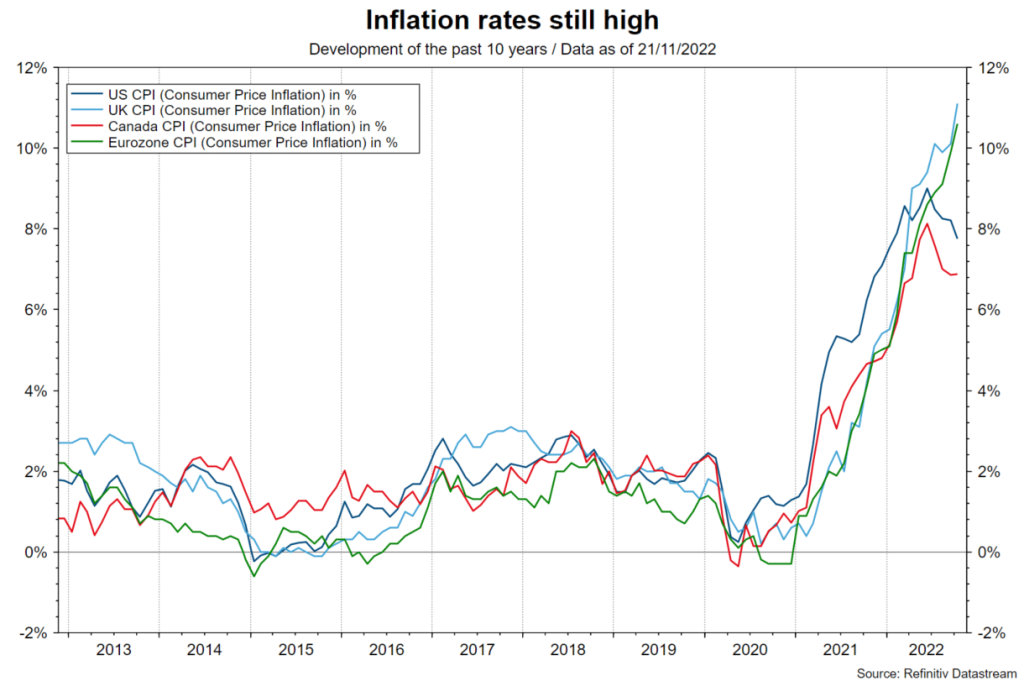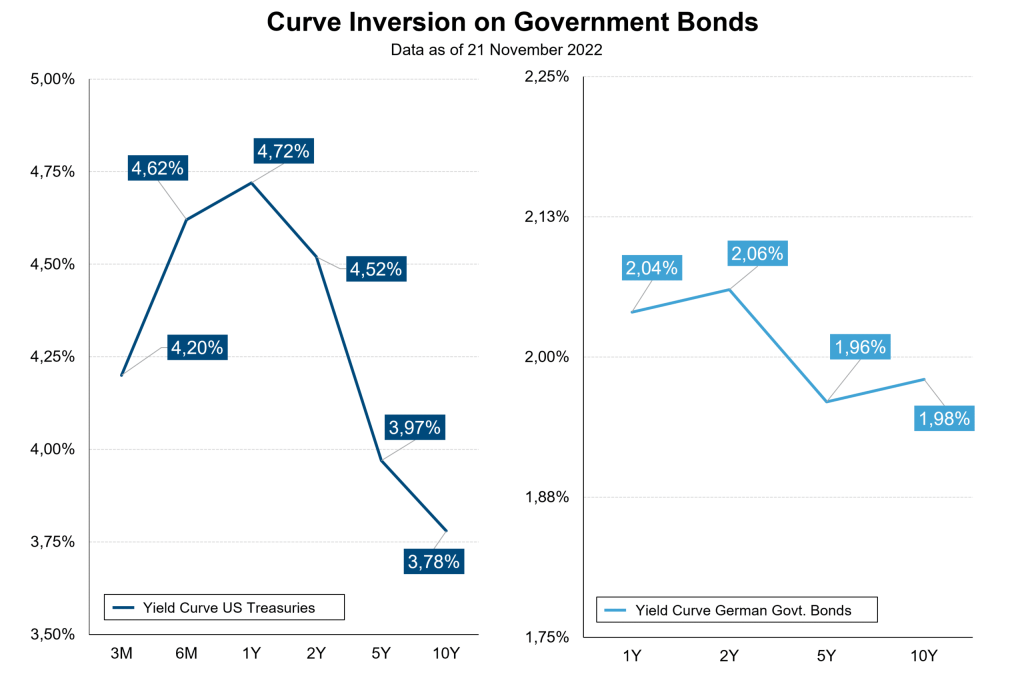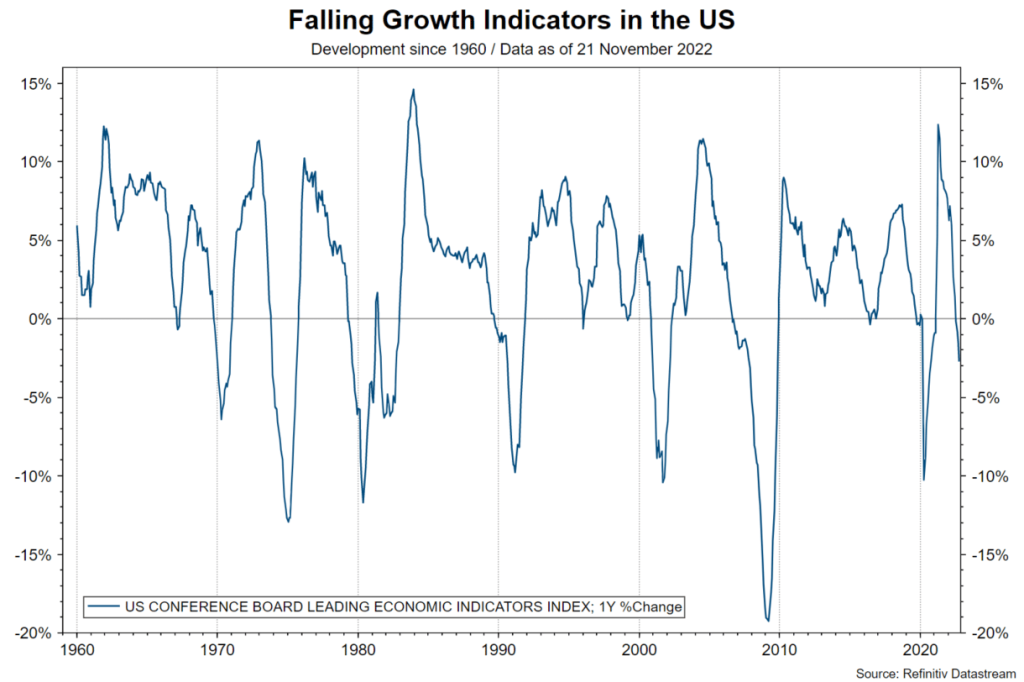There are growing signs of a gradual change in the driving factor for financial markets. So far, it has been higher-than-expected inflation indicators. In the future, it could be disappointingly weak indicators of economic activity.
High inflation rates
Inflation rates remain high. Last week, the publication of consumer prices in the euro zone for the month of October showed an increase of 1.5% month-on-month to 10.6% year-on-year. In the United Kingdom, inflation rose 2.0% month-on-month and 11.1% year-on-year. In Canada, inflation increased by 0.7% month-on-month to 6.9% year-on-year.

Note: Past performance is not a reliable indicator for future performance.
Declining inflationary pressure
At the producer level, however, inflationary pressure is already easing in many countries. In Germany, for example, producer prices fell by 4.2% month-on-month in October (to 34.5% year-on-year). In the USA, producer price inflation has already been significantly lower since July (October: 0.2% p.m., 8.8% p.a.). Moreover, consumer prices in the US were also below expectations in October, at 0.4% month-on-month and 7.7% year-on-year. Of course, it will take some time before the sharp rise in producer prices is fully passed on to consumer prices (first-round effects). However, assuming that second-round effects remain subdued (no wage-price spiral), inflation rates will fall next year. However, uncertainty remains high as to the level at which inflation will settle.
Interest rate policy with a rear-view mirror
Because evidence is mounting for a temporary end to inflation surprises, and policy rates have already been raised significantly, central banks are signaling a reduction in the pace of rate hikes and a pause (perhaps even an end) in the rate hike cycle. This has supported asset prices in recent weeks. However, monetary policy is already having a restrictive effect, that is, a dampening effect on economic activity. This policy will be maintained as long as inflation persistence, i.e. the relationship between current and past inflation, remains high and the labor market remains tight. In other words, only when inflation rates have fallen significantly is a departure from the restrictive policy likely. Monetary policy is currently acting with a rearview mirror because inflation dynamics are not well understood.
Curve inversion
Already, numerous indicators point to negative economic momentum. On the market side, the difference between the two-year and ten-year US government bond yields has risen to minus 0.7 percentage points. Meanwhile, the difference between the three-month interest rate and the ten-year yield is also negative (minus 0.4 percentage points). In Germany, too, the interest rate differential between the two-year and ten-year yields is negative, albeit only slightly at 0.07 percentage points. The short maturities reflect a restrictive interest rate policy. This reduces inflation and economic growth. The long-dated yields essentially consist of the sum of the expected short-dated interest rates. The long maturities are therefore already pricing in key interest rate cuts. Statistically, a so-called curve inversion is a good recession indicator. Of course, a “soft” landing, i.e. a weakening of growth and inflation without a recession, could materialize next year. However, the probability argues against this.

Falling growth indicators
In addition, numerous indicators continue to tend toward weakness. This can be seen, among other things, in the segments that are particularly sensitive to interest rates (construction). In the USA, the NAHB Housing Market Index is in free fall. In the G4 (USA, UK, Eurozone, Japan), banks have tightened lending standards significantly. The manufacturing sector is also increasingly pointing to contraction. For example, exports are falling in some key countries in Asia (South Korea: -17% y/y in November, Singapore: -6% y/y in October, China: -0.3% y/y in October, export orders in Taiwan: -6% y/y in October). In the US, the Conference Board’s Leading Index has fallen for the eighth consecutive month-to-month to minus 2.7% y/y. Also in the U.S., the Chicago Fed’s National Activity Index has slipped into negative territory (indicating GDP contraction) and the Philadelphia Fed’s Business Outlook Index is edging closer to recession territory with another decline for the month of November.

Note: Past performance is not a reliable indicator for future performance.
In Europe, a moderate GDP contraction is likely in the fourth quarter of 2022 and the first quarter of 2023. For the United Kingdom, a significant GDP decline is on the horizon between the third quarter of 2022 and the second quarter of 2023. The recently presented government austerity package of GBP 55 billion will also dampen economic activity in the medium term. In China, the Corona containment measures and the slump on the real estate market are reducing domestic demand. China’s economy is expected to grow by only around 3% in 2022. The recently presented easing measures (more liquidity for developers, less stringent bank regulation) will only be able to help the real estate sector in the medium term (several months).
Conclusion
The environment of slightly falling inflation rates, persistently restrictive monetary policies and falling growth indicators generally favors bonds over equities. The assessment that key interest rates will be raised to a restrictive level and will remain there for some time may by now be sufficiently reflected in bond yields. Rising yields this year have sharply reduced the value of future coupon payments on outstanding bonds. As a result, bond prices have been subject to strong downward pressure. This negative process may be coming to an end. As a result of the rise in yields, the attractiveness of bonds has thus increased. At the same time, the risks to economic growth have increased, as have those to future corporate profits. This could be a headwind for share prices next year.
For a glossary of technical terms, please visit this link: Fund Glossary | Erste Asset Management
Legal note:
Prognoses are no reliable indicator for future performance.
Legal disclaimer
This document is an advertisement. Unless indicated otherwise, source: Erste Asset Management GmbH. The language of communication of the sales offices is German and the languages of communication of the Management Company also include English.
The prospectus for UCITS funds (including any amendments) is prepared and published in accordance with the provisions of the InvFG 2011 as amended. Information for Investors pursuant to § 21 AIFMG is prepared for the alternative investment funds (AIF) administered by Erste Asset Management GmbH pursuant to the provisions of the AIFMG in conjunction with the InvFG 2011.
The currently valid versions of the prospectus, the Information for Investors pursuant to § 21 AIFMG, and the key information document can be found on the website www.erste-am.com under “Mandatory publications” and can be obtained free of charge by interested investors at the offices of the Management Company and at the offices of the depositary bank. The exact date of the most recent publication of the prospectus, the languages in which the fund prospectus or the Information for Investors pursuant to Art 21 AIFMG and the key information document are available, and any other locations where the documents can be obtained are indicated on the website www.erste-am.com. A summary of the investor rights is available in German and English on the website www.erste-am.com/investor-rights and can also be obtained from the Management Company.
The Management Company can decide to suspend the provisions it has taken for the sale of unit certificates in other countries in accordance with the regulatory requirements.
Note: You are about to purchase a product that may be difficult to understand. We recommend that you read the indicated fund documents before making an investment decision. In addition to the locations listed above, you can obtain these documents free of charge at the offices of the referring Sparkassen bank and the offices of Erste Bank der oesterreichischen Sparkassen AG. You can also access these documents electronically at www.erste-am.com.
Our analyses and conclusions are general in nature and do not take into account the individual characteristics of our investors in terms of earnings, taxation, experience and knowledge, investment objective, financial position, capacity for loss, and risk tolerance. Past performance is not a reliable indicator of the future performance of a fund.
Please note: Investments in securities entail risks in addition to the opportunities presented here. The value of units and their earnings can rise and fall. Changes in exchange rates can also have a positive or negative effect on the value of an investment. For this reason, you may receive less than your originally invested amount when you redeem your units. Persons who are interested in purchasing units in investment funds are advised to read the current fund prospectus(es) and the Information for Investors pursuant to § 21 AIFMG, especially the risk notices they contain, before making an investment decision. If the fund currency is different than the investor’s home currency, changes in the relevant exchange rate can positively or negatively influence the value of the investment and the amount of the costs associated with the fund in the home currency.
We are not permitted to directly or indirectly offer, sell, transfer, or deliver this financial product to natural or legal persons whose place of residence or domicile is located in a country where this is legally prohibited. In this case, we may not provide any product information, either.
Please consult the corresponding information in the fund prospectus and the Information for Investors pursuant to § 21 AIFMG for restrictions on the sale of the fund to American or Russian citizens.
It is expressly noted that this communication does not provide any investment recommendations, but only expresses our current market assessment. Thus, this communication is not a substitute for investment advice.
This document does not represent a sales activity of the Management Company and therefore may not be construed as an offer for the purchase or sale of financial or investment instruments.
Erste Asset Management GmbH is affiliated with the Erste Bank and austrian Sparkassen banks.
Please also read the “Information about us and our securities services” published by your bank.

